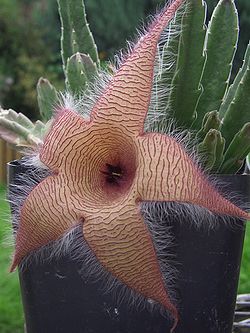Stapelia gigantea
| Stapelia gigantea subsp. var. | Giant stapelia | |||||||||||||||||||||||||||||||||||||||||||||||||||||||
|---|---|---|---|---|---|---|---|---|---|---|---|---|---|---|---|---|---|---|---|---|---|---|---|---|---|---|---|---|---|---|---|---|---|---|---|---|---|---|---|---|---|---|---|---|---|---|---|---|---|---|---|---|---|---|---|---|

|
|
| ||||||||||||||||||||||||||||||||||||||||||||||||||||||
| ||||||||||||||||||||||||||||||||||||||||||||||||||||||||
Stapelia gigantea is a flowering plant in the Stapelia genus of plants commonly referred to as the Carrion or Toad Plant (although the name Carrion Plant can also refer to Stapelia grandiflora). Stapelia gigantea sometimes also goes by the name of Stapelia nobilis and Stapelia marlothii.
| Standard Cyclopedia of Horticulture |
|---|
|
Stapelia gigantea, N. E. Br. Sts. erect, branching from a short decumbent base, 4-8 in. high, pubescent, light dull green, angles much compressed: fls. 1 or 2 together, near the base or toward the middle of the sts.; corolla 11-16 in. diam., disk-like, center shallowly depressed, inner surface transversely rugulose, pale-purple-hairy, light ochre-yellow, everywhere marked with transverse crimson lines, lobes 4 – 6 1/4 in. long. Trop. and S. Afr. — "The requirements of S. gigantea," Watson writes, "are somewhat exceptional. It thrives only when grown in a hot, moist stove from April till September, when the growth matures and the flower-buds show. It should then be hung up or placed upon a shelf near the roof-glass in a sunny dry position in the stove." CH
|
Cultivation
Propagation
Pests and diseases
Varieties
Gallery
-
photo 1
-
Stems
-
Stems closeup
-
Flower and bud
References
External links
- w:Stapelia gigantea. Some of the material on this page may be from Wikipedia, under the Creative Commons license.
- Stapelia gigantea QR Code (Size 50, 100, 200, 500)



